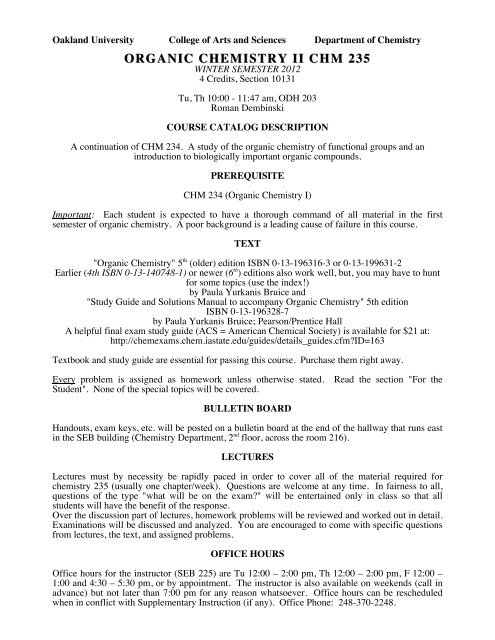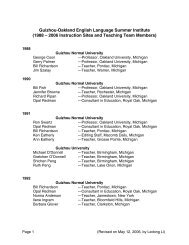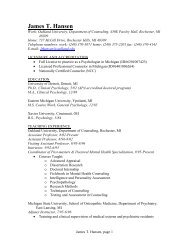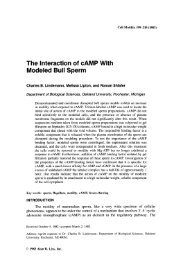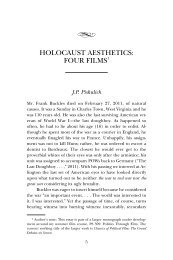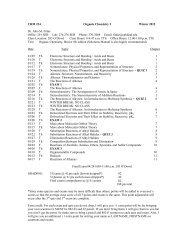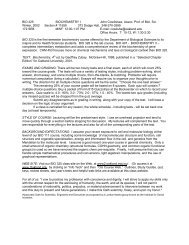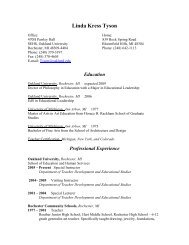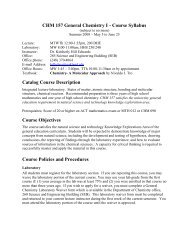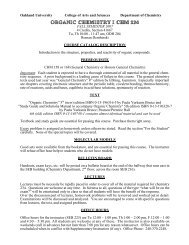ORGANIC CHEMISTRY II CHM 235 - Oakland University
ORGANIC CHEMISTRY II CHM 235 - Oakland University
ORGANIC CHEMISTRY II CHM 235 - Oakland University
Create successful ePaper yourself
Turn your PDF publications into a flip-book with our unique Google optimized e-Paper software.
<strong>Oakland</strong> <strong>University</strong> College of Arts and Sciences Department of Chemistry<strong>ORGANIC</strong> <strong>CHEMISTRY</strong> <strong>II</strong> <strong>CHM</strong> <strong>235</strong>WINTER SEMESTER 20124 Credits, Section 10131Tu, Th 10:00 - 11:47 am, ODH 203Roman DembinskiCOURSE CATALOG DESCRIPTIONA continuation of <strong>CHM</strong> 234. A study of the organic chemistry of functional groups and anintroduction to biologically important organic compounds.PREREQUISITE<strong>CHM</strong> 234 (Organic Chemistry I)Important: Each student is expected to have a thorough command of all material in the firstsemester of organic chemistry. A poor background is a leading cause of failure in this course.TEXT"Organic Chemistry" 5 th (older) edition ISBN 0-13-196316-3 or 0-13-199631-2Earlier (4th ISBN 0-13-140748-1) or newer (6 th ) editions also work well, but, you may have to huntfor some topics (use the index!)by Paula Yurkanis Bruice and"Study Guide and Solutions Manual to accompany Organic Chemistry" 5th editionISBN 0-13-196328-7by Paula Yurkanis Bruice; Pearson/Prentice HallA helpful final exam study guide (ACS = American Chemical Society) is available for $21 at:http://chemexams.chem.iastate.edu/guides/details_guides.cfm?ID=163Textbook and study guide are essential for passing this course. Purchase them right away.Every problem is assigned as homework unless otherwise stated.Student". None of the special topics will be covered.Read the section "For theBULLETIN BOARDHandouts, exam keys, etc. will be posted on a bulletin board at the end of the hallway that runs eastin the SEB building (Chemistry Department, 2 nd floor, across the room 216).LECTURESLectures must by necessity be rapidly paced in order to cover all of the material required forchemistry <strong>235</strong> (usually one chapter/week). Questions are welcome at any time. In fairness to all,questions of the type "what will be on the exam?" will be entertained only in class so that allstudents will have the benefit of the response.Over the discussion part of lectures, homework problems will be reviewed and worked out in detail.Examinations will be discussed and analyzed. You are encouraged to come with specific questionsfrom lectures, the text, and assigned problems.OFFICE HOURSOffice hours for the instructor (SEB 225) are Tu 12:00 – 2:00 pm, Th 12:00 – 2:00 pm, F 12:00 –1:00 and 4:30 – 5:30 pm, or by appointment. The instructor is also available on weekends (call inadvance) but not later than 7:00 pm for any reason whatsoever. Office hours can be rescheduledwhen in conflict with Supplementary Instruction (if any). Office Phone: 248-370-2248.
CONTENTS OF LECTURESChapter 12. Mass Spectrometry, Infrared Spectroscopy and Ultraviolet/Visible SpectroscopyChapter 13. NMR SpectroscopyChapter 14. Aromaticity. Reactions of BenzeneChapter 15. Reactions of Substituted BenzenesChapter 16. Carbonyl Compounds I: Nucleophilic Acyl SubstitutionChapter 17. Carbonyl Compounds <strong>II</strong>: Reactions of Aldehydes and Ketones. More Reactions ofCarboxylic Acid Derivatives. Reactions of α,β-Unsaturated Carbonyl CompoundsChapter 18. Carbonyl Compounds <strong>II</strong>I: Reactions at the α-CarbonChapter 19. More About Oxidation-Reduction ReactionsChapter 20. More About Amines. Heterocyclic CompoundsChapter 21. CarbohydratesChapter 22. Amino Acids, Peptides, and ProteinsChapter 23. CatalysisChapter 26. LipidsChapter 27. Nucleosides, Nucleotides, and Nucleic AcidsSCHEDULE OF LECTURES and EXAMINATIONSWeek #1 (1-January) Tu,Th lecture 1Week #2 (2-January) Tu,Th lectures 2-3Week #3 (15-January) Tu,Th lectures 4-5Week #4 (22-January) Tu,Th lectures 6-7Week #5 (29- January) Tu,Th exam, lecture 8 (also half of the lecture after exam)Examination #1 chapters 1(12)-15: Tuesday 31-JanuaryWeek #6 (5-February) Tu,Th lectures 9-10Week #7 (12-February) Tu,Th lectures 11-12Week #8 (19-February) winter recessWeek #9 (26-February) Tu,Th lecture 13, exam (also half of the lecture after exam)Examination #2 chapters 1(15)-18: Thursday 1-MarchWeek #10 (4-March) Tu,Th lectures 14-15Week #11 (11-March) Tu,Th lectures 16-17Week #12 (18-March) Tu,Th lectures 18-19Week #13 (25-March) Tu,Th lecture 20, exam (also half of the lecture after exam)Examination #3 chapters 1(19)-21: Thursday 29-MarchWeek #14 (1-April) Tu,Th lectures 21-22Week #15 (8-April) Tu,Th lectures 23-24Week #16 (15April) Tu,Th lecture 25Final examination: Thursday 19-April 8:00-11:00 AM (same room, ACScomprehensive; please bring scantron form 882-E or equivalent for 100 answers)OTHER EXAMINATION DETAILS(1) A grade of 0 (zero) is assigned for missed exams. There are no make-up exams. Anycircumstances involving illness or deaths must be (a) communicated in advance of the exam, and(b) fully documented, with signed statements from a medical doctor (not a chiropractor) or a countycoroner. Voice mail may be left at (248) 370-2248.(2) ID checks will be required at the examinations.(3) Students are responsible for checking their exams for blank or missing pages (the number ofpages and problems will be indicated on the face page).(4) You will not be permitted to leave the examination room in the middle of the exams and returnto continue the examination. If you have a medical problem that makes this policy troublesome,please notify me as soon as possible so we can resolve the problem before it arises. The use ofcellular phones (also during class), radio/MP3 players with headsets, graphing calculators, or anyother electronic device not approved by the instructor will not be allowed. Also, no hats, waterbottles, and please turn off cellular phones during exams. It is recommended not to bring theseitems to the examination room.(5) Any and all incidents of cheating will be referred to Academic Conduct Committee. Studentsfound guilty of academic misconduct will receive a zero (0) grade for this course. For further-2-
details see Academic Conduct Policies section (p. 82 – 83) in the 2011 – 2012 UndergraduateCatalog or online at http://www2.oakland.edu/catalog/undergrad/index.cfm .(6) Errors can occur in grading. If you have grading questions on your exam, take the followingsteps: (a) check your answers vs. those on the key that is posted on the bulletin board (across theroom SEB 216); do not write on or mark your exam; (b) meet with the instructor. No regrading willbe allowed five working days after the return of an exam. Graded exams will be copied prior totheir return.(7) If you have a documented disability and wish to discuss academic accommodations, pleasecontact me as soon as possible.COURSE GRADINGEach midterm will count as 20% of the course grade, and the final will count as 40% of the coursegrade. Grades will not be assigned to individual exams, but rankings (distribution curves) will beposted. "Wild Card Rule": The instructors reserve the right to factor "surprise quizzes" into thefinal grades (up to 15% total).Grade distributions (%) previously given by the instructor in Chemistry 234 and <strong>235</strong> include:A B C D 0(zero)10 36 17 14 2325 21 18 18 1828 11 44 11 623 21 33 21 213 18 38 23 820 8 39 31 225 28 27 12 826 13 42 16 316 16 34 9 2529 18 22 27 419 14 33 21 1338 16 29 14 318 9 38 26 924 10 22 36 8Incompletes: The official <strong>University</strong> policy will be rigorously followed, which means it will bealmost impossible for anyone to be given an incomplete.Withdrawals: The official <strong>University</strong> policy will be rigorously followed.The following grading was used for this course last offering (points out of 500)0.0 99 and below 2.5 250 and above1.0 100 and above 2.6 260 and above1.1 110 and above 2.7 270 and above1.2 120 and above 2.8 280 and above1.3 130 and above 2.9 290 and above1.4 140 and above 3.0 300 and above1.5 150 and above 3.1 310 and above1.6 160 and above 3.2 320 and above1.7 170 and above 3.3 330 and above1.8 180 and above 3.4 340 and above1.9 190 and above 3.5 350 and above2.0 200 and above 3.6 360 and above2.1 210 and above 3.7 370 and above2.2 220 and above 3.8 380 and above2.3 230 and above 3.9 390 and above2.4 240 and above 4.0 400 and aboveASSIGNMENTSIt is expected that the following will be completed in advance of the specified chapter lectures:Read the chapter, complete all problems within the chapter, and complete all additionalproblems at the end of the chapter.-3-
Suggestions for Answering Mechanistic Exam Questions<strong>ORGANIC</strong> <strong>CHEMISTRY</strong> (<strong>CHM</strong> 234 and <strong>235</strong>)Roman DembinskiWhen you are asked to give a mechanism for a transformation, provide: (1) structures for allenergy minima on the energy-reaction coordinate diagram, and (2) means for interconverting theseminima by the "arrow" (two electron) and "fishhook" (one electron) formalisms. Additionalguidelines are as follows:A. Do not take shortcuts with proton transfers.Incorrect:(i)O -R C ORH 2 NR+RO -HC OR+HNRWhile the above two species are in equilibrium, the equation does not depict the mechanismby which equilibrium is achieved.Correct:(ii)RHO -CN +ORRRHO -CN..ORR+HHO +HRHO -CNHOR+RH+H 2 O:H 2 OB. Make sure that each step is mass balanced and charge balanced.C. Make sure that all catalysts are regenerated.D. Use appropriate arrow formalisms for distinguishing equilibria ( ), irreversible steps(→), and resonance structures (↔). The symbol for indicating equivalence of two differentperspectives of a molecule is ≡.E. When merited by appropriate evidence, indicate which steps are slow (i.e., rate determining)and fast.F. Make sure that your mechanism adequately accounts for the stereochemistry of the reaction.Three-dimensional representations of all intermediates may be required.G. Clearly indicate when final products are reached; for reactions involving more than oneproduct and several steps, some products might be generated before others.-4-


